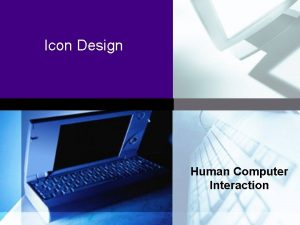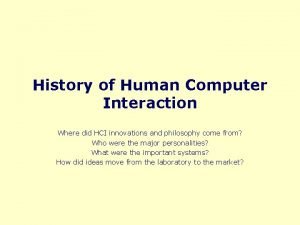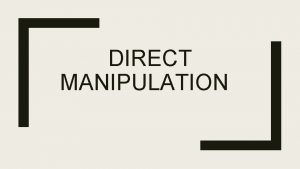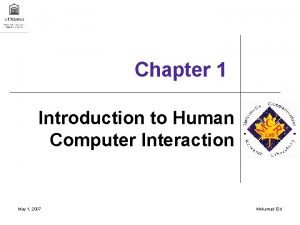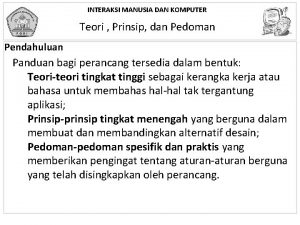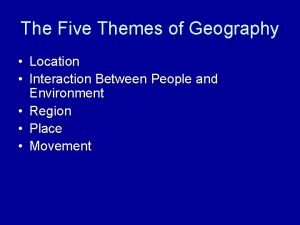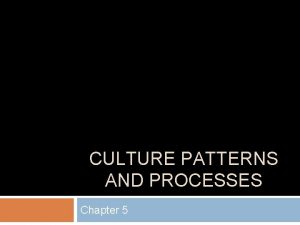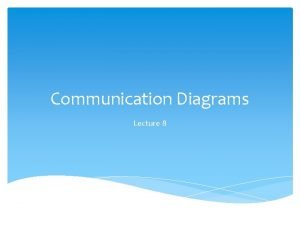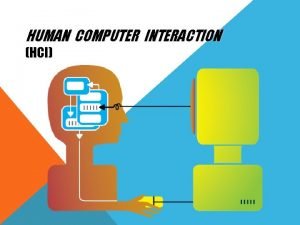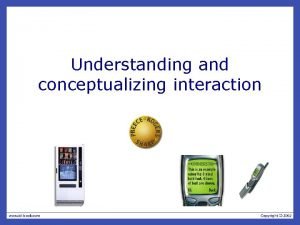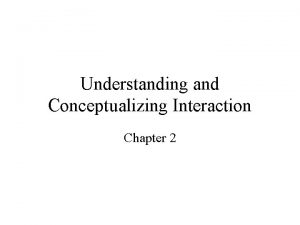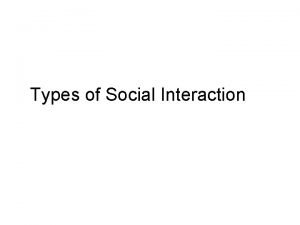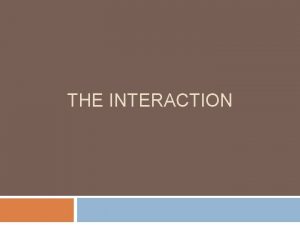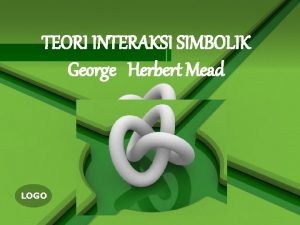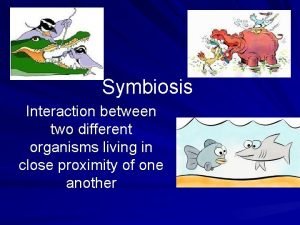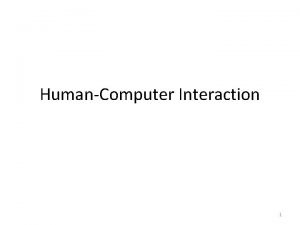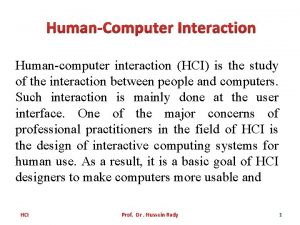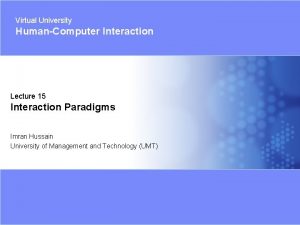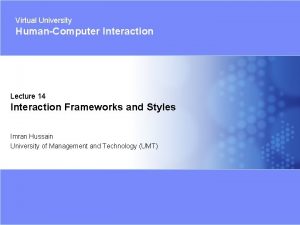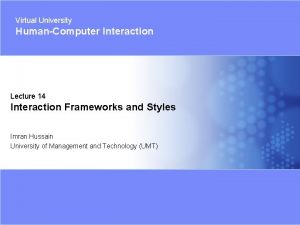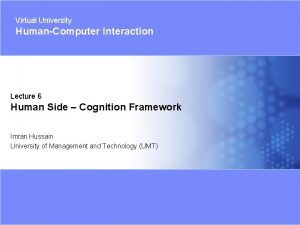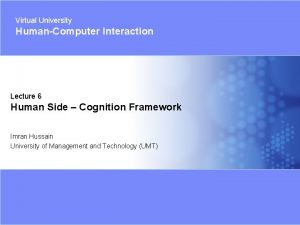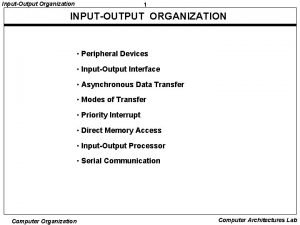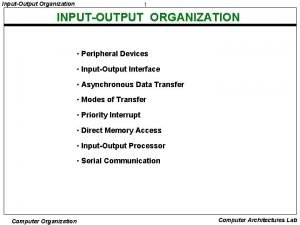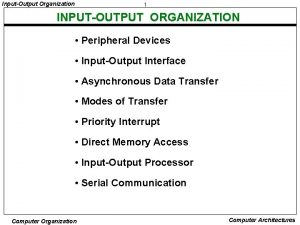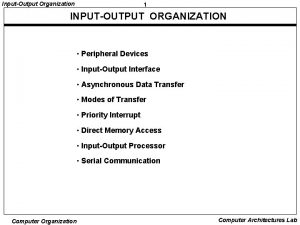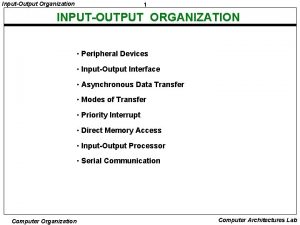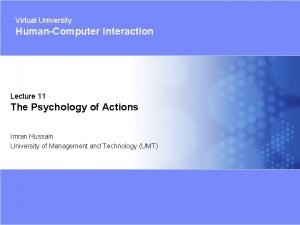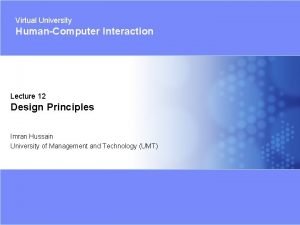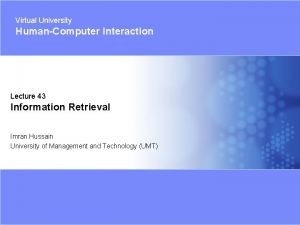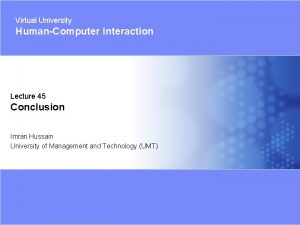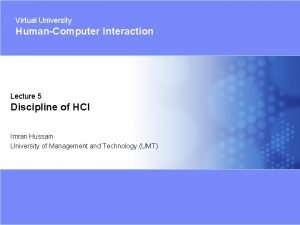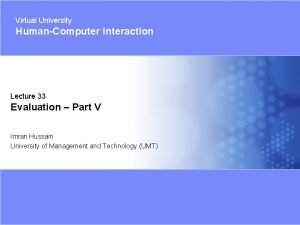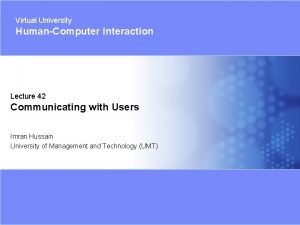Virtual University HumanComputer Interaction Lecture 8 Human InputOutput






























































- Slides: 62

Virtual University Human-Computer Interaction Lecture 8 Human Input-Output Channels - Part II Imran Hussain University of Management and Technology (UMT) 1 Virtual University - Human Computer Interaction © Imran Hussain | UMT

In the Last Lecture • Input-Output Channels • Input via Senses • Output via Effectors • Vision • Human Eye • Visual Perception • Capabilities and Limitations 2 Virtual University - Human Computer Interaction © Imran Hussain | UMT

Input via Senses • Vision • Hearing • Touch • Taste • Smell 3 Virtual University - Human Computer Interaction © Imran Hussain | UMT

Output via Effectors (Responders) • Limbs • Fingers • Eyes • Head • Vocal system 4 Virtual University - Human Computer Interaction © Imran Hussain | UMT

Human Eye 5 Virtual University - Human Computer Interaction © Imran Hussain | UMT

Visual Perception • Size • Depth • Brightness • Color 6 Virtual University - Human Computer Interaction © Imran Hussain | UMT

Factors Affecting Visual Perception • Perception of depth – Cues to determine relative positions of objects • Objects overlapping • Size and height of object – Provides cue for distance • Familiarity – Certain size helps to judge the distance accordingly 7 Virtual University - Human Computer Interaction © Imran Hussain | UMT

Perceiving Brightness • Brightness – subjective reaction to levels of light – affected by luminance of object • Luminance – Depends on • Amount of light falling on object • Reflective properties of object – Measured by photometer • Contrast – Function of the luminance of an object and the luminance of its background 8 Virtual University - Human Computer Interaction © Imran Hussain | UMT

Perceiving Color • 3 components – Hue • Determined by the spectral wavelength – Blue (short) – Green (medium) – Red (long) • 150 hues determined by eye – Intensity • Brightness of color – Saturation • Amount of whiteness in the color • 7 million colors can be perceived 9 Virtual University - Human Computer Interaction © Imran Hussain | UMT

Over Compensation Illusions • Optical illusions sometimes occur due to over compensation – Our perception of size is not reliable concave convex the Muller Lyer illusion the Ponzo illusion 10 Virtual University - Human Computer Interaction © Imran Hussain | UMT

Proof-Reading Illusion 11 Virtual University - Human Computer Interaction © Imran Hussain | UMT

In Today’s Lecture • Vision – Color Theory – 3 D Vision – Reading • Hearing – Human Ear – Processing Sound • Touch (Haptic Perception) – Skin Physiology – Types of haptic senses • Movement – Movement Perception 12 Virtual University - Human Computer Interaction © Imran Hussain | UMT

Why Study Color? • Color can be a powerful tool to improve user interfaces, but its inappropriate use can severely reduce the performance of the systems we build 13 Virtual University - Human Computer Interaction © Imran Hussain | UMT

Color • Sensory response to electromagnetic radiation in the spectrum between wavelengths 0. 4 - 0. 7 micrometers 14 Virtual University - Human Computer Interaction © Imran Hussain | UMT

Color Theory • Primary Color • Secondary Color • Tertiary Color • Color Harmony • Color Context 15 Virtual University - Human Computer Interaction © Imran Hussain | UMT

Color Theory • Primary Color – Red, yellow and blue – 3 pigment colors that can not be mixed – Can not be formed by any combination of other color PRIMARY COLORS Red, yellow and blue • Secondary Color – formed by mixing the primary colors SECONDARY COLORS Green, orange and purple • Tertiary Color – formed by mixing one primary and one secondary color TERTIARY COLORS Yellow-orange, red-purple, blue-green and yellow-green 16 Virtual University - Human Computer Interaction © Imran Hussain | UMT

Color Harmony • pleasing arrangement of parts, whether it be music, poetry, color, or even an ice cream sundae • When something is not harmonious, it's either boring or chaotic • extreme unity leads to under-stimulation • extreme complexity leads to over-stimulation. • Harmony is a dynamic equilibrium. 17 Virtual University - Human Computer Interaction © Imran Hussain | UMT

Color Harmony • Some Formulas for Color Harmony – analogous colors • any three colors which are side by side on a 12 part color wheel • yellow-green, yellow, and yellow-orange • Usually one of the three colors predominates. A color scheme based on analogous colors 18 Virtual University - Human Computer Interaction © Imran Hussain | UMT

Color Harmony • Some Formulas for Color Harmony – complementary colors • any two colors which are directly opposite each other • red and green and red-purple and yellow-green A color scheme based on complementary colors 19 Virtual University - Human Computer Interaction © Imran Hussain | UMT

Color Harmony • Nature provides a perfect departure point for color harmony • red yellow and green create a harmonious design, regardless of whether this combination fits into a technical formula for color harmony A color scheme based on nature 20 Virtual University - Human Computer Interaction © Imran Hussain | UMT

Color Context • How color behaves in relation to other colors and shapes is a complex area of color theory. • Compare the contrast effects of different color backgrounds for the same red square 21 Virtual University - Human Computer Interaction © Imran Hussain | UMT

Color Context • Different readings of the same color Which is the lighter vertical bar? Figure a 22 Virtual University - Human Computer Interaction Figure b © Imran Hussain | UMT

Color Perception via Cones • Photopigments” used to sense color • 3 types – blue, green, “red” (really yellow) – each sensitive to different band of spectrum – ratio of neural activity of the 3 color • other colors are perceived by combining stimulation 23 Virtual University - Human Computer Interaction © Imran Hussain | UMT

Color Perception via Cones 24 Virtual University - Human Computer Interaction © Imran Hussain | UMT

Color Sensitivity from: http: //www. cs. gsu. edu/classes/hypgraph/coloreff. htm 25 Virtual University - Human Computer Interaction © Imran Hussain | UMT

Color Sensitivity 26 Virtual University - Human Computer Interaction © Imran Hussain | UMT

Distribution of Photopigments • Photopigments” used to sense color • Not distributed evenly – mainly reds (64%) & very few blues (4%) ? • insensitivity to short wavelengths – cyan to deep-blue • Center of retina (high acuity) has no blue cones ? – disappearance of small blue objects you fixate on 27 Virtual University - Human Computer Interaction © Imran Hussain | UMT

Color Sensitivity & Image Detection • Most sensitive to the center of the spectrum – blues & reds must be brighter than greens & yellows • Brightness determined mainly by R+G – combine brightness & color differences for sharpness • Shapes detected by finding edges • Implications? – hard to deal w/ blue edges & blue shapes 28 Virtual University - Human Computer Interaction © Imran Hussain | UMT

Color Sensitivity & Image Detection • As we age – lens yellows & absorbs shorter wavelengths ? • sensitivity to blue is even more reduced – fluid between lens and retina absorbs more light • perceive a lower level of brightness • Implications? – don’t rely on blue for text or small objects! – older users need brighter colors 29 Virtual University - Human Computer Interaction © Imran Hussain | UMT

Focus • Different wavelengths of light focused at different distances behind eye’s lens – need for constant refocusing ? • causes fatigue – be careful about color combinations 30 Virtual University - Human Computer Interaction © Imran Hussain | UMT

Focus • Different wavelengths of light focused at different distances behind eye’s lens – need for constant refocusing ? • causes fatigue – be careful about color combinations • Pure (saturated) colors require more focusing then less pure (desaturated) – don’t use saturated colors in UIs unless you really need something to stand out (stop sign) 31 Virtual University - Human Computer Interaction © Imran Hussain | UMT

Color Guidelines • Opponent colors go well together – (red & green) or (yellow & blue) – Hering's opponent colors diagram • Pick non-adjacent colors on the hue circle 32 Virtual University - Human Computer Interaction © Imran Hussain | UMT

Color Guidelines • Size of detectable changes in color varies – hard to detect changes in reds, purples, & greens – easier to detect changes in yellows & blue-greens • Older users need higher brightness levels to distinguish colors • Hard to focus on edges created by color alone ? – use both brightness & color differences • Avoid red & green in the periphery - why? – lack of RG cones there -- yellows & blues work in periphery 33 Virtual University - Human Computer Interaction © Imran Hussain | UMT

Color Guidelines • Avoid pure blue for text, lines, & small shapes – blue makes a fine background color – avoid adjacent colors that differ only in blue • Avoid single-color distinctions – mixtures of colors should differ in 2 or 3 colors • e. g. , 2 colors shouldn’t differ only by amount of red – helps color-deficient observers 34 Virtual University - Human Computer Interaction © Imran Hussain | UMT

Color Guidelines • Accurate color discrimination – -+60 degree of straight head position. – Not uniform across the whole field of vision • Limit of color awareness – -+90 degree of straight head position • Cultural issue – Society classifies color differently 35 Virtual University - Human Computer Interaction © Imran Hussain | UMT

3 D vision • give an immediate perception of depth on the basis of the difference in points of view of the two eyes. • Also known as binocular vision and stereopsis • most reliable clue for depth • This is possible only when the eyes of a creature look in the same direction, and have overlapping fields. • Stereopsis gives a reliable distance clue as far away as 450 meters 36 Virtual University - Human Computer Interaction © Imran Hussain | UMT

2 D to 3 D • Strong Clues – apparent sizes of objects of known size – overlapping and parallax – shadows and perspective • Weaker Clues – atmospheric perspective (haze and scattering) – speed of movement – observed detail • Strongest Clue – stereopsis 37 Virtual University - Human Computer Interaction © Imran Hussain | UMT

2 D to 3 D • free fusion – – – Keep two pictures side by side each eye sees its picture straight ahead a third, fused, image appears strikingly solid Brain regards this real one • stereo pair – The two images are called a stereo pair 38 Virtual University - Human Computer Interaction © Imran Hussain | UMT

Reading • Stages 1. visual pattern perceived 2. decoded using internal representation of language 3. interpreted using knowledge of syntax, semantics, pragmatics 39 • Reading involves saccades and fixations (perception here: 94%) • Perception occurs during fixations • Regressions: eye move backwards and forwards • Word shape is important to recognition Virtual University - Human Computer Interaction © Imran Hussain | UMT

Reading • Negative contrast improves reading from computer screen • Average Reading Speed: 250 words per minute – Word shape important: Bat, BAT • Reading speed is a measure of legibility – Font sizes …. • Reading from computer screen slower due to … • Legibility can be increased using negative contrast … 40 Virtual University - Human Computer Interaction © Imran Hussain | UMT

Human Auditory Perception • Second to sight • We under estimate amount of info received via ears • Lets hear a few sounds – Sound 1 of a Vehicle coming Towards you – Sound 2 of a Vehicle going away from you 41 Virtual University - Human Computer Interaction © Imran Hussain | UMT

Hearing • Provides information about environment: distances, directions, objects etc. • Vibration in air – Sound Waves • Human Ear – Outer – Middle – Inner Ear 42 Virtual University - Human Computer Interaction © Imran Hussain | UMT

Human Ear • Outer Ear – Visible part divided into two • Pinna • Auditory Cannal • Outer ears purpose – Protect middle ear from damage – Middle ear temperature maintenance – Pinna and Cannal amplify some sounds • Middle Ear – Tympanic membrane or ear drum connection to outer ear – Cochlea to inner ear – Ossicles (smallest bones in the body) • Inner Ear – Filled with Cochlea fluid – Within are Cilia which bend with vibration and cause impulses to brain. 43 Virtual University - Human Computer Interaction © Imran Hussain | UMT

Processing Sound • Sound characteristics – Pitch • frequency of sound – Loudness • proportional to amplitude of sound – Timbre • relates to type of sound 44 Virtual University - Human Computer Interaction © Imran Hussain | UMT

Processing Sound • Audible range 20 Hz to 15 KHz • Distinguish between changes less than 1. 5 Hz but less accurate at higher frequencies • Different frequencies trigger neuron activity causing nerve impulses • Auditory system filters sounds – Cocktail Party Effect: can attend to sounds over background noise • Sound rarely used in interface design 45 Virtual University - Human Computer Interaction © Imran Hussain | UMT

Touch 46 Virtual University - Human Computer Interaction © Imran Hussain | UMT

Touch (Haptic Perception) • Close your eyes and pick a cup of tea • What can you tell about the cup? • Can you identify its material ? • Is it hot of cold • What is the texture • Can you find the handle? • Speed and accuracy reduced without touch 47 Virtual University - Human Computer Interaction © Imran Hussain | UMT

Touch (Haptic Perception) 48 • What has this got to do with Computers? • Imagine a key board where you cannot feel the buttons pressed? • Have you ever noticed the “marking” on “F” and “J” keys ? • How your Mobile phone has an indicator to digit 5 ? • Virtual Reality has no touch • Provides important feedback about environment. • May be key sense for someone who is visually impaired - braille Virtual University - Human Computer Interaction © Imran Hussain | UMT

How haptic interaction works? From MIT “Touch. Lab” 49 Virtual University - Human Computer Interaction © Imran Hussain | UMT

Types of human haptic sensing • Tactile – sense stimulus though the skin – heat, pain, pressure, texture (cutaneous) • Kinesthesia – sense of limb motions – affects comfort and performance – Due to receptors in joints: • Rapidly adapting: limb in particular direction • Slowly adapting: limb movement and static • Positional receptors: limb static • Proprioception – awareness of limb locations – movements and shapes, temperature, and pain 50 Virtual University - Human Computer Interaction © Imran Hussain | UMT

Types of human haptic sensing • active & passive touch – “exploratory procedures”: directed manipulations to determine specific properties of touched objects 51 Virtual University - Human Computer Interaction © Imran Hussain | UMT

Skin Physiology • Some areas more sensitive than others e. g. fingers. – 2 -point threshold test • 2 pencils: place 12 mm apart on thumb and move • >distance => > sensitivity • Fingers have highest acuity (10 x forearms) – Spatial resolution of about 2. 5 mm • Multiple forces closer are sensed as one • Stimulus received via sensory receptors in the skin – thermoreceptors – heat and cold – nociceptors – pain – Mechanoreceptors: pressure (of concern in HCI) • Rapidly adapting (immediate and increased pressure) • Slowly adapting (continuously applied pressure) 52 Virtual University - Human Computer Interaction © Imran Hussain | UMT

Movement (Motor Control) • Time taken to respond to stimulus: reaction time + movement time • Movement time dependent on age, fitness etc. • Reaction time - dependent on stimulus type: – visual – auditory – pain ~ 200 ms ~ 150 ms ~ 700 ms • Increasing reaction time decreases accuracy in the unskilled operator but not in the skilled operator. 53 Virtual University - Human Computer Interaction © Imran Hussain | UMT

Movement • Speed and accuracy – Relationship between the two? – Depends on skill: typists 54 Virtual University - Human Computer Interaction © Imran Hussain | UMT

Movement • Fitts' Law describes the time taken to hit a screen target (function of size of target and distance that has to be moved): Mt = a + b log 2(D/S + 1) where: a and b are empirically determined constants Mt is movement time D is Distance S is Size of target Þ targets as large as possible distances as small as possible 55 Virtual University - Human Computer Interaction © Imran Hussain | UMT

Movement Perception • Three modes of viewing a moving object – hold our heads and eyes still as a moving object passes in front of us – Stare at bird – Perceive Car moves from right to left. 56 Virtual University - Human Computer Interaction © Imran Hussain | UMT

Movement Perception • hold our heads still and let our eyes follow the object – image remains on the fovea during the motion of the car and your eyes. 57 Virtual University - Human Computer Interaction © Imran Hussain | UMT

Movement Perception • hold our eyes steady and move only our head to follow an object – This causes the image to project to exactly the same retinal location at each instant (assuming you move your head at precisely the correct angular velocity) as the car moves from right to left. 58 Virtual University - Human Computer Interaction © Imran Hussain | UMT

Movement Perception • Motion After Effect – Known as adaptation effect – when the stimulus is not moving – a waterfall example • Explanation – motion detection system • motion detectors • undergo spontaneous activity • Phi phenomenon – motion being seen, when there is no physical motion – two illuminated spots of light about 6 to 8 inches apart • Films and Cartoons – Still frames are rapidly projected. 59 Virtual University - Human Computer Interaction © Imran Hussain | UMT

Movement Perception • induced motion – Sit in a stationary train – When any other train passes next to you – You feel moving • Auto kinetic movement – view a small very dim light in an otherwise completely dark room – After sometime in the dark, the small light will appear to move somewhat randomly • Cortical neuron – specialized for movement – respond best when the motion is in a specific direction 60 Virtual University - Human Computer Interaction © Imran Hussain | UMT

Smell/olfaction • Nose and Computing ? ? ? • Experiments are being done to transmit smells across the net • Biometric devices to identify one person from another 61 Virtual University - Human Computer Interaction © Imran Hussain | UMT

Next Lecture • Memory Structures 62 Virtual University - Human Computer Interaction © Imran Hussain | UMT
 Inputoutput devices
Inputoutput devices 01:640:244 lecture notes - lecture 15: plat, idah, farad
01:640:244 lecture notes - lecture 15: plat, idah, farad Mit csail hci course review
Mit csail hci course review Hci symbol
Hci symbol Paradigms of interaction
Paradigms of interaction Visual channel in hci
Visual channel in hci Interaction framework in hci
Interaction framework in hci Direct manipulation interaction style
Direct manipulation interaction style Hci chapter 1
Hci chapter 1 Pola pikir desainer imk dibawah ini adalah
Pola pikir desainer imk dibawah ini adalah Yang termasuk model antarmuka objek-aksi
Yang termasuk model antarmuka objek-aksi Hei ap human geography
Hei ap human geography Spatial interaction ap human geography
Spatial interaction ap human geography Portland absolute location
Portland absolute location Spatial interaction ap human geography
Spatial interaction ap human geography Interaction design syllabus
Interaction design syllabus Human environment interaction egypt
Human environment interaction egypt What is human geography
What is human geography What is geography?
What is geography? Pengertian human computer interaction
Pengertian human computer interaction Linguistic diversity ap human geography
Linguistic diversity ap human geography Functional regions
Functional regions Human environment interaction
Human environment interaction Alan dix hci
Alan dix hci What is a functional region
What is a functional region Cultural diffusion def
Cultural diffusion def Human computer interaction diagram
Human computer interaction diagram Ergonomics in human computer interaction
Ergonomics in human computer interaction Hci merupakan
Hci merupakan Rome human environment interaction
Rome human environment interaction Human resources department structure
Human resources department structure Chapter 1 introduction to human resource management
Chapter 1 introduction to human resource management Human resource management lecture chapter 1
Human resource management lecture chapter 1 Has virtual functions and accessible non-virtual destructor
Has virtual functions and accessible non-virtual destructor Virtual university mba
Virtual university mba Leeds pathology slides
Leeds pathology slides Virtual university examination system
Virtual university examination system Elearning uvt
Elearning uvt National virtual university
National virtual university University of delaware virtual microscope
University of delaware virtual microscope 沈榮麟
沈榮麟 Western washington university human services
Western washington university human services Augusta university job openings
Augusta university job openings Siue hr forms
Siue hr forms Southern oregon university human resources
Southern oregon university human resources Fsu human resources
Fsu human resources Human vs non human bones
Human vs non human bones Chapter 8 human needs and human development
Chapter 8 human needs and human development Chapter 8 human needs and human development
Chapter 8 human needs and human development Gni definition ap human geography
Gni definition ap human geography Non human nouns
Non human nouns Planar trans-1 2-dimethylcyclohexane
Planar trans-1 2-dimethylcyclohexane What is real-time interaction management
What is real-time interaction management Total physical interaction
Total physical interaction What is problem space in hci
What is problem space in hci Conceptual model in hci
Conceptual model in hci Conceptualization interaction
Conceptualization interaction Cooperation social interaction
Cooperation social interaction Law of interaction
Law of interaction Abowd and beale’s model
Abowd and beale’s model Logo interaction
Logo interaction Tapeworm and dog symbiotic relationship
Tapeworm and dog symbiotic relationship Two different organisms living together
Two different organisms living together



